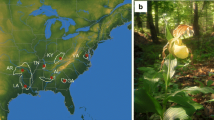Abstract
For the first time, microsatellite loci were used to study the genetic structure in Alectoris chukar cypriotes. Four of the ten tested microsatellite loci were found to be polymorphic in 33 individuals from four regions of Cyprus. The differentiation test between all the pairs of samples gave non-differentiation exact P values in every case (P>0.05). The posterior probability distribution on the number of source populations indicated only one population (P=0.977); also, a high Bayes factor value (130.020) was obtained. Posterior co-assignment probabilities (measures of similarity) for all pairs of individuals ranged from 0.984 to 1. The global FIS value was not found to be significant. A recent bottleneck of the Cypriot total partridge population is suggested and this is supported by a significant Wilcoxon test (P=0.031) under the Infinite Alleles Model (IAM) and shifted mode in the alleles frequencies distribution. The results suggest that all the individuals studied belong to only one randomly mating (panmictic) population, with low genetic variation and evidence of recent effective population size reduction (genetic bottleneck). A big hunting pressure exists on the island and about 200,000 captive-bred birds are released every year; these individuals are descendant from a small number of eggs collected in a small area of Cyprus in 1986 and this founder effect could explain the existence of a bottleneck and the low genetic variability.

Similar content being viewed by others
References
Arruga MV, Garcìa CB, Monteagudo LV, Tejedor MT (2004) Análisis de microsatélites en poblaciones de Perdiz Roja española. XV seminario de genética de poblaciones y evolución. Sigüenza (Spain), Noviembre 2004
Belkhir KP, Borsa P, Goudet P, Chikhi L, Bonhomme F (1996–1998) ENETIX, logiciel sous Windows TM pour la génétique des populations. Laboratoire du genome et populations, CNRS UPR 9060, Université de Montpellier II, Montpellier (France) <http://www.univ-montp2.fr/∼genetix/#programmes>
BirdLife International (2004) Birds in Europe: population estimates, trends and conservation status. Cambridge, UK: BirdLife International (BirdLife Conservation series No. 12)
Budowle B (1991) AMPFLPS-Genetic markers for forensic identification. Crim Lab Digest 18:134–136
Cornuet JM, Luikart G (1997) Description and power analysis of two tests for detecting recent population bottleneck from allele frequency data. Genetics 144:2001–2014 <http://www.montpellier.inra.fr/URLB/bottleneck/pub.html>
Dawson KJ, Belkhir K (2001) A Bayesian approach to the identification of panmictic populations and the assignment of individuals. Genet Res 78:59–77 <http://www.univ-montp2.fr/∼genetix/partition/partition.htm#download>
Felsenstein J (1980–2004) PHYLIP: phylogeny inference package. <http://evolution.gs.washington.edu/phylip.html>
Hadjisterkotis E (1999) Überlebenschancen von in gefangenschaft aufgezogenen und zur bestandsaufstockung ausgewilderten chukarhühnern (Alectoris chukar cypriotes). The survival of captive bred chukar Alectoris chukar cypriotes, released for restocking in Cyprus. Z Jagdwiss 45:238–249
Hadjisterkotis E, Papamichael C (1994) Breeding the chukar partridge in cyprus. Game bird breeders and conservationists’ gazzette: September 1994:30–46
Hanotte O, Pugh A, Maücher C, Dawson D, Burke T (1997) Nine novel chicken microsatellite loci and their utility in other galliformes. Anim Genet 28:311–313
Heukeshoven J, Dernick R (1985) Simplified method for silver staining of proteins in polyacrylamide gels and the mechanism of silver staining. Electrophoresis 6:103–112
Johnsgard PA (1988) The quails partridges, and francolins of the world. Oxford University Press, Oxford New York Tokyo
Luikart G, Cornuet JM (1998) Empirical evaluation of a test for identifying recently bottlenecked populations from allele frequency data. Conserv Biol 12:228—237
Luikart G, Allendorf FW, Cornuet JM, Sherwin WB (1998a) Distortion of allele frequency distributions provides a test for recent population bottlenecks. J Hered 89:238–247
Luikart G, Sherwin WB, Steele BM, Allendorf FW (1998b) Usefulness of molecular markers for detecting population bottlenecks via monitoring genetic change. Mol Ecol 7:963–974
Marshall TC, Slate J, Kruuk LEB, Pemberton JM (1998) Statistical confidence for likelihood-based paternity inference in natural population. Mol Ecol 7:639–655 <http://helios.bto.ed.ac.uk/evolgen/cervus/abstract.html>
Meuwissen THE (1999) Operation of conservation schemes. In: Oldenbroek JK (ed) Genebanks and the conservation of farm animal genetic resources. DLO Institute for Animal Science and Health, Lelystad, The Nederlands, pp 33–58
Pang SWY, Ritland C, Carlson JE, Cheng KM (1999) Japanese quail microsatellite loci amplified with chicken-specific primers. Anim Genet 30:195–199
Schneider S, Roessli D, Excoffier L (2000) ARLEQUIN ver 2.000: a software for population genetics data analysis. Genetics and Biometry Laboratory, University of Geneva, Switzerland. <http://anthro.unige.ch/arlequin>
Toro M, Mäki-Tanila A (1999) Establishing a conservation scheme. In: Oldenbroek JK (ed) Genebanks and the conservation of farm animal genetic resources. DLO Institute for Animal Science and Health, Lelystad, The Nederlands, pp 75–90
Wright S (1965) The interpretation of population structure by F-statistics with special regard to systems of mating. Evolution 19:395–420
Wright S (1978) Evolution of the genetics of populations, vol 4. Variability within and among natural populations. University of Chicago Press, Chicago
Acknowledgements
This study was funded in part by INIA-CICYT (reference number RZ01-009). We would like to thank A. Dimitriades, M. Pahitanis, C. Tsioutis, and A. Chrisostomou for assistance in the collection of feathers for the analyses. We are also grateful to Dr D. Savva (University of Reading, UK) for help in polishing the English original. The authors declare that the experiments comply with the current laws of both Cyprus and Spain.
Author information
Authors and Affiliations
Corresponding author
Rights and permissions
About this article
Cite this article
Tejedor, M.T., Monteagudo, L.V., Hadjisterkotis, E. et al. Genetic variability and population structure in Cypriot chukar partridges (Alectorischukar cypriotes) as determined by microsatellite analysis. Eur J Wildl Res 51, 232–236 (2005). https://doi.org/10.1007/s10344-005-0103-2
Received:
Accepted:
Published:
Issue Date:
DOI: https://doi.org/10.1007/s10344-005-0103-2




